Understanding the Two-Child Cap
The policy, introduced by George Osborne in 2017, applies to children born after 6 April that year. It restricts universal credit and child tax credits for third or subsequent children, impacting around 1.6 million children in the UK. According to analysis reviewed by Finance Monthly, affected families forgo an average of £4,400 annually, which represents about 10% of their disposable income. Child benefit remains available for all children, unaffected by the cap. The policy's name can cause confusion, but it specifically targets means-tested benefits.
Exceptions and Key Details
The rules include exemptions for certain situations. These cover multiple births like twins or triplets, children from non-consensual conceptions, adoptions, and placements in foster or kinship care. These provisions aim to address specific needs while maintaining the overall limit. Claiming under these exceptions involves detailed applications, which can add complexity for families already under pressure.
Recent Signals from the Chancellor
Reeves addressed the issue in a recent House of Commons session, stating that larger families should not face penalties through the benefits system. This follows pressure from Labour MPs and advocacy groups focused on child poverty. Prime Minister Keir Starmer has supported exploring options, potentially including funding from adjustments to higher earners' taxes. The Institute for Fiscal Studies estimates the cap saves £3.6 billion each year. As the Budget approaches, discussions continue on how to balance support with public finances, especially with ongoing economic challenges.

The two-child benefit cap reforms could affect how much families receive, representing a potential shift in government payouts.
The Fiscal Tightrope: Costs, Savings, and a Hidden Economic Win
Removing the cap completely would cost the Treasury an estimated £3.6 billion per year, according to the Institute for Fiscal Studies. Options like partial payments for additional children could lower this to around £2 billion, depending on the structure. Extending the cap to cover three children might add £2.6 billion to spending. These figures could influence decisions on taxes or other budget areas, affecting taxpayers broadly.
A closer look reveals an often-overlooked benefit. Investing in family support through this change could yield long-term savings. Child poverty currently costs the economy £3.2 billion annually in reduced productivity and higher health expenses, as outlined by the New Economics Foundation. In simple terms, this means that extra support today helps children stay healthier and perform better in school, leading to a stronger workforce tomorrow. It's an example of how targeted spending can generate returns by reducing future demands on public services.
For everyday households, this matters because persistent poverty contributes to higher local taxes for social support and could push up national costs like VAT in the long run. Consider one Manchester family who, in a modelled scenario, gained £3,800 after similar adjustments; they used it for after-school programs that improved their child's school results and future earning potential.
Paul Johnson, director at the Institute for Fiscal Studies, highlights the broader impact. "This policy has strained family finances over time, contributing to ongoing economic challenges that affect us all," he observed in recent analysis. A practical step for individuals is to check your tax code on the HMRC website, where you might recover £200 to £500 in overpaid tax. This small action can provide a buffer against any upcoming fiscal adjustments.
Who Benefits and Broader Impacts
The primary gains would go to low-income families with three or more children born after April 2017. They could see increases of several thousand pounds per year, helping with essentials and potentially easing poverty for around 350,000 children, based on recent estimates. This additional income might also support local spending, providing a modest lift to community economies. The government must consider these upsides alongside the £2.5 trillion national debt, ensuring changes align with sustainable planning.

Chancellor Rachel Reeves delivers her pre-Budget speech, outlining the UK’s fiscal challenges and potential tax rises.
Beyond the Headlines: What Readers Really Want to Know
What Exactly Is the Two-Child Benefit Cap and Why Does It Matter Now?
The two-child benefit cap limits extra universal credit or tax credits for third and later children born after April 2017, while leaving child benefit intact. It aims to save £3.6 billion yearly but has drawn criticism for increasing poverty in affected households by up to 10%. With Reeves' recent comments ahead of the 2025 Budget, the policy is under review as part of Labour's commitments to tackle child poverty, prompting fresh debate on its fairness and costs.
How Much Would Scrapping the Cap Truly Cost the UK Government?
Eliminating the cap would add £3.6 billion to annual spending, per Institute for Fiscal Studies data, possibly offset by changes like higher employer contributions. A tapered system, reducing payments gradually for additional children, might limit costs to £1.8 billion. Such reforms could help lift 630,000 children out of poverty, though they require careful management amid current debt levels and economic priorities.
My Opinion: Striking a Balance Between Support and Responsibility
In my view, the debate around the two-child benefit cap ultimately comes down to a balance between supporting families who genuinely need assistance and preventing the system from being exploited. There are households that rely on benefits to make ends meet and should rightfully receive support for their children. At the same time, the system should discourage patterns where individuals have multiple children without contributing to society through work or taxes.
Effective policy needs to create incentives for people to build their lives responsibly: to work, invest in their families, and contribute their fair share to public finances, while still ensuring that help is available for those who genuinely require it. Well-structured benefits can both protect vulnerable children and uphold the integrity of public spending, striking a middle ground between compassion and fiscal responsibility.














